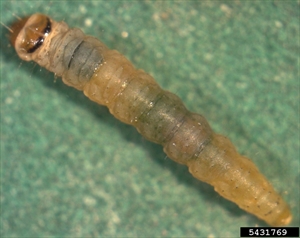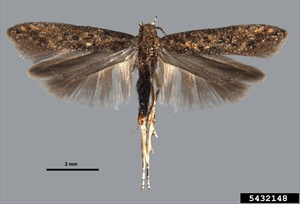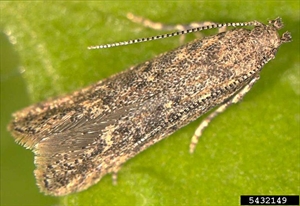Tomato leafminer. It is also known as the tomato pinworm or the South American tomato moth.
Pacific Pests, Pathogens and Weeds - Online edition
Pacific Pests, Pathogens & Weeds
Tomato leafminer (421)
Tuta absoluta. It has had several names since it was first described, the last being Scrobipalpuloides absoluta. A moth in the Gelechiidae.
Asia, Africa, South, Central America, Europe. It is not reported from Oceania.
Tomato is the primary host, but it is capable of attacking potato, eggplant, capsicum, and wild species in the potato family (Solanaceae).
The larvae do the damage attacking the flowers, mining the tender new leaves (Photo 1), tunnelling into the stems, and eating apical buds and young fruit. In heavy attacks, the plants look scorched from a distance.
The female lays about 250 cream-coloured eggs on the undersides of leaves, on the stem, or sometimes on the fruit. After hatching the larvae enter the leaves, stems or fruit; they are white at first, later greenish or light pink, up to 7.5 mm (Photo 2). The head is brown. When mature, the larvae may leave the mines and make a cocoon on the leaflets and pupate or pupate in the mines. Pupae are brown. Adults are up to 6-10 mm long, with wingspan of 10 mm. The forewings are silvery brown with black spots, the hindwings are fringed (Photos 3&4). Males are slightly darker than females. The females produce a pheromone to attract the males. The life cycle is 25-35 days, and 10-12 generations of the moth can occur each year.
Spread over short distances occurs on seedlings, fruit and containers. Over large distances, spread occurs in infested fruits, and packaging materials.
Severe economic damage has been done by this moth as it made its way from South America into North Africa, Europe, the Middle East, and then Asia. Crops may be destroyed. The result has seen increased tomato prices, restrictions on the trade in fruit, and increased pesticide use. The impact may not only be on tomato and related crops, but also on weed species of significant importance to biodiversity.
Look for damage to apical buds, flowers, and young fruits. Look for the mines on the leaves; they are irregular blotches filled will frass; leaves may be skeletonized during severe attacks. Look for holes, frass and webbing on stems and fruit. Look for a characteristic dark band behind the head of the larvae. Because there are other leafminers attacking tomatoes that are similar to Tuta absoluta, specimens should be examined by a Lepidopteran taxonomist.
BIOSECURITY
Countries not yet infested by the tomato leafminer should consider all likely pathways for entry, and apply quarantine measures accordingly. It is not present in Pacific island countries. National biosecurity organisations need to ensure that tomatoes (and fruit of other hosts) entering the country originate from crops certified free of tomato leafminer.
NATURAL EMEMIES
There are many parasitoid wasps reported to attack eggs and larvae, e.g., Necremnus, Trichogramma, and Pseudoapanteles species. Predators such as mirid bugs are used commercially, especially in North Africa and Europe.
CULTURAL CONTROL
Check CABI Tomato leafminer portal, Invasive Species Compendium for up-to-date information (https://www.cabi.org/ISC/tuta).
Before planting:
- Weed; remove alternative hosts, e.g., wild Solanum, Datura and Nicotiana species. The removal of nightshade species is particularly important.
- Practice crop rotation.
- Check transplants for presence of tomato leafminer damage before field planting.
- Crush larvae between finger and thumb if numbers in nursery or field are low.
- Monitor nurseries, and in fields using a trap containing a sex pheromone at least 2 weeks before planting (see under Chemical control).
During growth:
- Continue to weed, especially nightshades in the Solanum family.
- Stake plants to provide easier monitoring for damage, and application of insecticides.
- Inspect the crop regularly for signs of tomato leafminer damage.
- Use mass trapping if more than 3-4 moths are caught in monitoring traps (1 per crop). See below under Chemical control.
After harvest:
- Keep on trapping for 3 weeks after harvest.
- Avoid over-lapping crops. Leave a minimum of 6 weeks after harvest and destruction of the tomato crop until planting the next one.
- Collect and destroy debris after harvest.
- Cultivate the soil between crops; ideally use plastic mulch to solarise the soil, killing any pupae present.
CHEMICAL CONTROL
Many different types of insecticides have been used against the moth with only moderate success. The moth has developed resistance rapidly to organophosphates, permethrin and pyrethroids, abamectin, and spinosad. However, Bt used against early instars has given control. Nevertheless, it is important to rotate with other products to prevent the development of resistance to Bt. In organic production, neem is another choice.
Additionally, pheromone traps have been used widely, containing male attractants, often in combination with an insecticide. These take advantage of the fact that males emerge earlier than females, and the females mate several times. For mass trapping, use sticky traps or those with water + oil (plus pheromone). A simple bucket trap with pheromone and water at the bottom to drown the moths is sufficient. A rate of 45-50 traps per hectare is recommended.
____________________
When using a pesticide (or biopesticide), always wear protective clothing and follow the instructions on the product label, such as dosage, timing of application, and pre-harvest interval. Recommendations will vary with the crop and system of cultivation. Expert advice on the most appropriate pesticide to use should always be sought from local agricultural authorities.
AUTHOR Grahame Jackson
Information from CABI (2019) Tuta absoluta (tomato leafminer). Crop Protection Compendium. (https://www.cabi.org/cpc/datasheet/49260); and Tomato leaf miner (Tuta absoluta) (2015). Tomato leaf miner FS. Plant Health Australia.(https://www.planthealthaustralia.com.au/pests/tomato-leaf-miner-tuta-absoluta/); and from Tuta absoluta. Wikipedia. (https://en.wikipedia.org/wiki/Tuta_absoluta). Photo 1. Dr Andrea Minuto. Leaf mines caused by Tuta absoluta on tomato. CERSAA, Albenga (IT). (https://gd.eppo.int/taxon/GNORAB/photos). Photo 2&4 Marja van der Straten, NVWA Plant Protection Service, Bugwood.org. Photo 3 Sangmi Lee, Hasbrouck Insect Collection, Arizona State University, Bugwood.org.
Produced with support from the Australian Centre for International Agricultural Research under project HORT/2016/185: Responding to emerging pest and disease threats to horticulture in the Pacific islands, implemented by the University of Queensland and the Secretariat of the Pacific Community.







